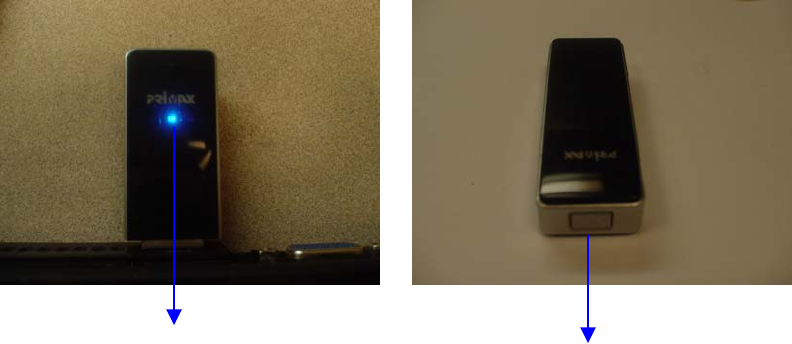Primax Electronics D7PBD2 Primax Bluetooth Dongle-2 User Manual PBD 2 user guide
Primax Electronics Ltd Primax Bluetooth Dongle-2 PBD 2 user guide
Users manual

Title: Primax PBD-2 User manual
Product Name: PBD-2
致伸科技股份有限公司
PRIMAX ELECTRONICS LTD. Version #: 1.0 Date: 2006/3/6
Primax Bluetooth Dongle
PBD-2 User Guide

1. Get started
The dongle contains a blue indicator light and a pairing button. It is shown in
the figure below.
Blue LED Pairing button
Driver
No driver and application needed if operating system is Windows 2000 or
Windows XP.
PIN
The PIN is 0000.
Blue LED indication
Pairing state: Fast blinking (200 ms blue and 200 ms off).
Paging state: Normal blinking (200 ms blue and 2000 ms off).
Connectable state: Slow blinking (200 ms blue and 5000 ms off).
Connected state: Continuously on.
Pairing button
User can press the Pairing button for more than 2 seconds, and then dongle
will enter into pairing state.
A headset is waiting for a connection
Scenario 1: If the dongle did NOT have connected to a headset in last
connection,
1. Plug the dongle to a computer.
2. The dongle will enter pairing state (fast blinking). Then the dongle
tries to discover and pair a headset.
3. Within 60 seconds, the headset answering the inquiry, the dongle
will transit to paging state (normal blinking).
4. Within 30 seconds, the dongle succeeds connecting to the headset,
and then the dongle will transit to connected state (continuously on).
Scenario 2: If the dongle has connected to a headset in last connection,
1. Plug the dongle to computer.
2. The dongle will enter paging state (normal blinking). The dongle
tries to discover and page a headset. The headset is the last one
device, which has been connected to the dongle.
3. Within 30 seconds, the dongle succeed connecting to the last
paired device, and then the dongle will transit to connected state
(continuously on).
No any headset is waiting for a connection
Scenario 1: If the dongle did NOT have connected to a headset in last
connection,
1. Plug the dongle to a computer.
2. The dongle will enter pairing state (fast blinking). Then the dongle tries
to discover and pair a headset.
3. After 60 seconds, no any headset answering the inquiry, the dongle will
transit to connectable state (slow blinking).
Scenario 2: If the dongle has connected to a headset in last connection,
1. Plug the dongle to computer.
2. The dongle will enter paging state (normal blinking). The dongle tries to
discover and page a headset. The headset is the last one device,
which has been connected to the dongle.
.
3. After 30 seconds, no any headset answering the paging, the dongle will
transit to connectable state (slow blinking).
Federal Communication Commission Interference Statement
This equipment has been tested and found to comply with the limits for a Class B digital
device, pursuant to Part 15 of the FCC Rules. These limits are designed to provide
reasonable protection against harmful interference in a residential installation. This
equipment generates, uses and can radiate radio frequency energy and, if not installed and
used in accordance with the instructions, may cause harmful interference to radio
communications. However, there is no guarantee that interference will not occur in a
particular installation. If this equipment does cause harmful interference to radio or television
reception, which can be determined by turning the equipment off and on, the user is
encouraged to try to correct the interference by one of the following measures:
- Reorient or relocate the receiving antenna.
- Increase the separation between the equipment and receiver.
- Connect the equipment into an outlet on a circuit different from that to which the receiver is
connected.
- Consult the dealer or an experienced radio/TV technician for help.
This device complies with Part 15 of the FCC Rules. Operation is subject to the following two
conditions: (1) This device may not cause harmful interference, and (2) this device must
accept any interference received, including interference that may cause undesired operation.
FCC Caution: Any changes or modifications not expressly approved by the party responsible
for compliance could void the user's authority to operate this equipment.
IMPORTANT NOTE:
FCC Radiation Exposure Statement:
This equipment complies with FCC radiation exposure limits set forth for an uncontrolled
environment. End users must follow the specific operating instructions for satisfying RF
exposure compliance.
This transmitter must not be co-located or operating in conjunction with any other antenna or
transmitter.